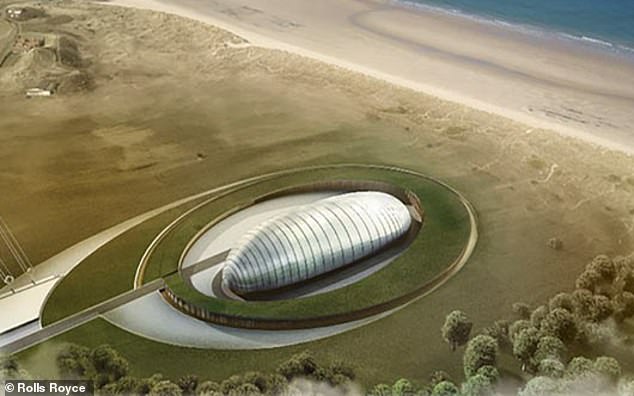Ministers consider £2bn aid plan to build 16 mini nuclear power stations by 2050
Up to £2billion could be put into a project to design and build mini-nuclear power stations.
Ministers are considering the huge injection of funds as the UK’s nuclear industry reels from crippling setbacks that could leave a gaping hole in the electricity supply.
The project to build 16 sites by 2050 could also revive ailing engineering titan Rolls-Royce, which is leading the nine-member consortium to design the ‘rapid assembly’ power stations.

The project to build 16 sites by 2050 could also revive ailing engineering titan Rolls-Royce, which is leading the nine-member consortium to design the ‘rapid assembly’ power stations
The group includes the National Nuclear Laboratory and Laing O’Rourke.
The pledge of between £1.5billion and £2billion is being discussed and is likely to be announced in the Treasury’s next spending review this year, sources told the Financial Times.
Government involvement could even see taxpayers taking an equity stake.
The £2billion is thought to be in addition to plans to provide the consortium £217million in 2021 and would be a way to attract outside investors.
The talks suggest ministers are keen to back the small modular reactor programme after attempts to build six large nuclear power stations have led to just one – Hinkley Point – going ahead.
If the 16 are built – all based on current nuclear sites – it could create 40,000 UK jobs.
In the last couple of years Japanese groups Toshiba and Hitachi have withdrawn from plans to build sites in Wales and Cumbria, with both citing financing as a major problem.
Hopes now rest on the approval of the Sizewell C nuclear plant in Suffolk, which is being led by France’s EDF and Chinese state-backed group CGN.
In January, the Government handed the Rolls-Royce-led coalition £18million to design the modular reactors.
The consortium matched the funding and is planning to have finished designs by next spring.
It then hopes to enter the second phase, a four-year licensing process to recruit staff and identify the sites for power stations and several factories to make parts.
The Government would provide £217million at that stage, which would also be matched by the coalition.
The first five sites are expected to cost £2.2billion, dropping to £1.8billion afterwards – paling in comparison to the £22.5billion Hinkley is expected to cost.
Although the technology already exists, the designs for ‘baby’ plants are new and could appeal to other countries.
An industry source said: ‘It’s a UK solution to a UK problem, but this also has huge export potential.’
It could also transform Rolls-Royce, the former jewel in the UK engineering crown that has hit difficulties, tipped into crisis by the pandemic, which has wiped out its main source of revenue from building and servicing aircraft engines.
To survive, it is now planning to sell multiple divisions and raise £5billion through a mixture of selling new shares and securing more debt.
